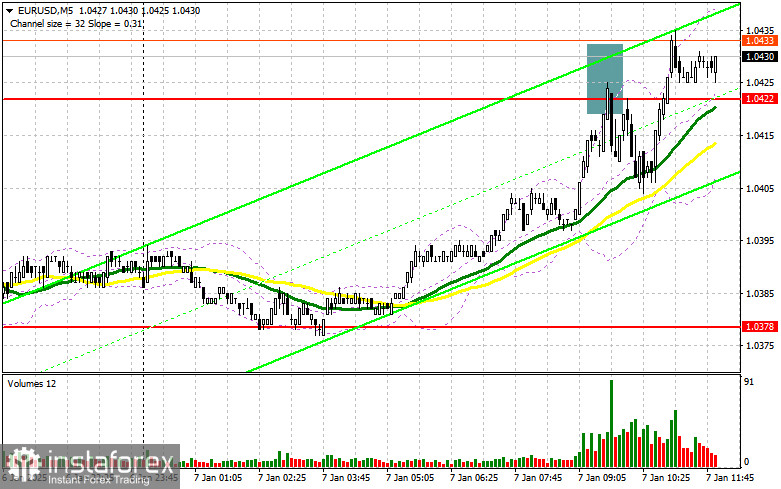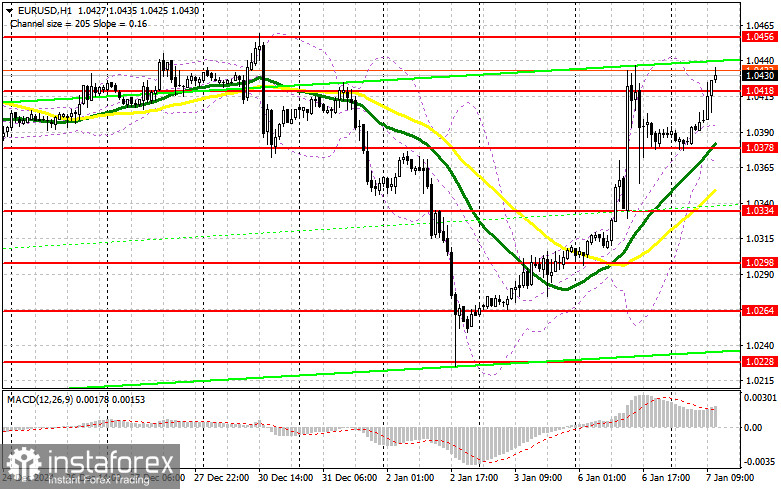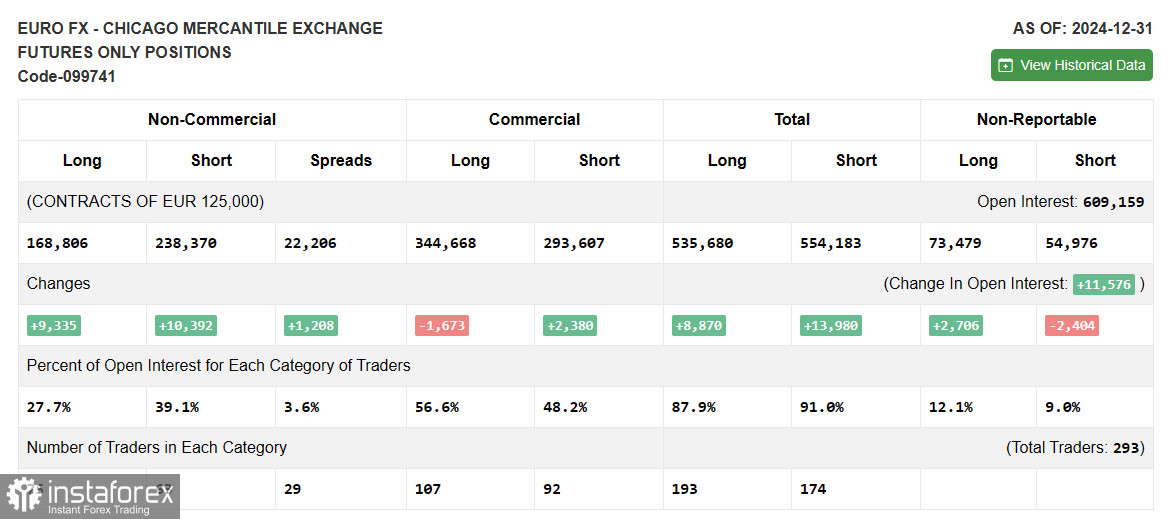In my morning forecast, I focused on the level of 1.0422 and planned to make market entry decisions based on it. Let's look at the 5-minute chart and analyze what happened there. The rise and formation of a false breakout near 1.0422 led to a good entry point for selling the euro, resulting in a pair's decline by only 18 points before demand returned. The technical picture has been revised for the second half of the day.

To Open Long Positions on EUR/USD:
News of a rise in Eurozone inflation in December allowed the euro to continue its growth against the U.S. dollar, which began yesterday. However, the fact that the data matched economists' forecasts prevented the bulls from achieving significant results. The second half of the day may also bring surprises. Key upcoming events include the U.S. ISM Services PMI for December and job openings and labor turnover data from the Bureau of Labor Statistics. Strong data, particularly from the services sector, could pressure the euro and lead to a stronger downward correction of the pair.
For this reason, I plan to act near the nearest support at 1.0378, formed earlier today. A false breakout at this level will lead to a good entry point for purchases, enabling a rebound to 1.0418, where trading is currently occurring. A breakout and retest of this range will confirm a proper entry point for buying with the target of 1.0456. The ultimate target will be the 1.0501 level, where I will fix profits. If EUR/USD declines and there is no activity around 1.0378 in the second half of the day, the pair's pressure will increase significantly, enabling sellers to push the pair to 1.0334. Only after forming a false breakout at this level will I consider buying the euro. I plan to open long positions immediately on a rebound from 1.0298, aiming for an upward correction of 30–35 points intraday.
To Open Short Positions on EUR/USD:
If the euro continues to rise amid weak U.S. data, particularly in the services sector, defending the 1.0456 resistance will be a priority for sellers. A false breakout there will provide an entry point for short positions, targeting support at 1.0418, where trading is currently focused. A breakout and consolidation below this range, followed by a retest from below, will be another suitable option for selling, aiming for the 1.0378 low, where moving averages are supporting the bulls. This will also cancel buyers' plans for a new bullish market and trap the pair within a sideways channel. The ultimate target will be the 1.0334 level, where I will fix profits. If EUR/USD continues to rise in the second half of the day and bears fail to act near 1.0456, I will postpone short positions until testing the next resistance at 1.0501. I will sell there only after an unsuccessful consolidation. I plan to open short positions immediately on a bounce from 1.0534, targeting a downward correction of 30–35 points.

The COT (Commitment of Traders) report for December 31 showed an increase in both short and long positions in almost equal proportions. Considering the Federal Reserve's monetary policy remained unchanged before the New Year, attention will likely shift to Donald Trump's inauguration and his protectionist rhetoric. However, statements from Federal Reserve representatives will also play a significant role in the future direction of the U.S. dollar and cannot be ignored. The COT report indicates that non-commercial long positions increased by 9,335 to 168,806, while non-commercial short positions rose by 10,392 to 238,370. As a result, the gap between long and short positions widened by 1,208.

Indicator Signals:
Moving Averages:
Trading is conducted above the 30- and 50-day moving averages, indicating further euro growth.
Note: The period and prices of moving averages are based on the H1 hourly chart and differ from the general definition of classical daily moving averages on the D1 daily chart.
Bollinger Bands:
In case of a decline, the lower boundary of the indicator near 1.0378 will act as support.
Indicator Descriptions:
- Moving Average (determines the current trend by smoothing volatility and noise). Period – 50 (marked in yellow on the chart);
- Moving Average (determines the current trend by smoothing volatility and noise). Period – 30 (marked in green on the chart);
- MACD Indicator (Moving Average Convergence/Divergence – determines momentum changes). Fast EMA – period 12; Slow EMA – period 26; SMA – period 9;
- Bollinger Bands (indicates levels of overbought and oversold). Period – 20;
- Non-commercial traders include individuals, hedge funds, and large institutions using the futures market for speculative purposes and meeting certain criteria;
- Non-commercial long positions represent the total long open positions of non-commercial traders;
- Non-commercial short positions represent the total short open positions of non-commercial traders;
- The total non-commercial net position is the difference between short and long non-commercial positions.





















